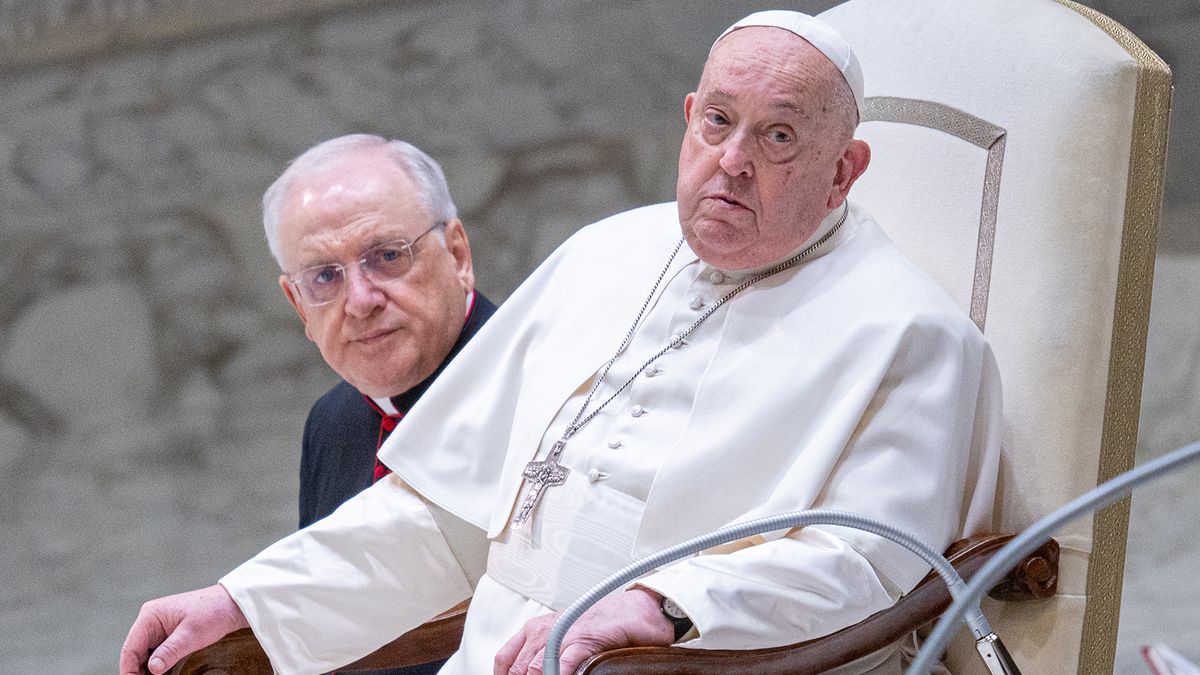Pope Francis is being treated in hospital for bilateral pneumonia, otherwise known as double pneumonia, according to a statement released by the Holy See Press Office on Tuesday (Feb.18). Vatican News shared details of the announcement the same day.
The statement noted that Pope Francis, 88, was hospitalized on Friday (Feb. 14) after experiencing bronchitis symptoms for several days. Tuesday’s statement described the pope’s condition as still being “a complex picture.”
It added that he has a “polymicrobial infection,” meaning an infection driven by multiple germs. The infection arose in the context of one chronic and one acute lung condition, respectively called bronchiectasis and asthmatic bronchitis. The statement added that the pope remained “in good spirits” and was spending his time alternating “between rest, prayer and reading.”
On Wednesday (Feb. 19) the Holy See Press Office released an update, published on Vatican News, which stated: “The Holy Father’s clinical condition is stable. The blood tests, evaluated by the medical staff, show a slight improvement, particularly in the inflammatory indices.”
Related: How do people die of the flu?
Here’s what to know about double pneumonia and the pope’s other respiratory conditions.
What is double pneumonia?
Pneumonia is typically caused by bacteria, viruses or fungi infecting the lungs and the body reacting to that infection. This causes inflammation, swelling and fluid accumulation in the small sacs of the lungs, called alveoli.
There are many different microorganisms that can cause the condition, including those responsible for the common cold, the flu and COVID-19. (Pneumonia can also sometimes arise when food or drinks are inhaled into the lungs, causing “aspiration pneumonia.”) Bacterial pneumonia is more common and usually more severe than viral pneumonia, which is more likely to cause mild symptoms that resolve on their own, according to nonprofit medical center Cleveland Clinic.
Common symptoms of pneumonia include chest pain, difficulty breathing, fever, chills, nausea, vomiting and persistent cough. If the condition becomes severe, it can lead to life-threatening complications, including heart damage, death of lung tissue, respiratory failure, or acute respiratory distress, which prevents the lungs from properly filling with air.
Notably, the pope has a polymicrobial infection, which means it is caused by multiple different microorganisms, and as such may require more complex treatment.
Double, or bilateral, pneumonia means that the infection has affected both of the pope’s lungs. He is now being treated with antibiotics, which fight bacterial infections, and corticosteroids, which help suppress inflammation, according to Tuesday’s statement.
Severe pneumonia is also often treated with oxygen therapy or a ventilator, but the statement did not note if the pope has received such breathing support.
Who is at risk of pneumonia?
Anyone can develop pneumonia, but some groups of people face a higher risk of the condition.
Those who are most at risk include older adults and young children; those with a chronic lung or heart condition; those with a neurological condition that affects swallowing; hospital patients or individuals living in care facilities; smokers; pregnant people; and those with weakened immune systems.
According to the National Center for Health Statistics, part of the U.S. Centers for Disease Control and Prevention (CDC), more than 41,000 people died from pneumonia in the U.S. in 2023 and 1.4 million emergency department visits were primarily due to pneumonia in 2021.
Most people with pneumonia are treated with antibiotics and will recover after two to four weeks, according to the U.K. National Health Service (NHS) website, but adults over 65 are more likely to require hospital treatment and experience more severe illness.
What is bronchitis, asthmatic bronchitis and bronchiectasis?
Pope Francis was particularly at risk of developing pneumonia because he already had several conditions affecting his lungs, such as bronchiectasis.
Bronchiectasis is a long-term condition where the bronchi — the major airways of the lungs that branch off the windpipe — widen, leading to more mucus than usual to build up in these airways. This can put the lungs at greater risk of subsequent infections. Bronchiectasis can be caused by damage to the tissue and muscles surrounding the bronchi, which might have happened due to a previous lung infection, for example.
Symptoms of bronchiectasis vary widely from person to person, but usually include shortness of breath and a persistent cough that brings up phlegm, according to the NHS website.
The Holy See statement also noted the pope had asthmatic bronchitis. This is a condition in which an individual has both asthma and acute bronchitis, causing symptoms such as chest tightness, wheezing, difficulty breathing and fever.
Bronchitis, broadly, is a disorder where the bronchi become inflamed. It is more common in people with asthma because asthma constricts these airways and also makes them hypersensitive to irritants. This can lead to bacteria or viruses getting trapped and causing damage.
Pope Francis may also be particularly prone to lung problems because, as a younger man, he developed a condition called pleurisy and had part of one of his lungs removed, age 21. Pleurisy is a condition characterized by inflammation of the lining of the lungs and chest cavity, which can cause sharp chest pains, especially when breathing in, coughing, sneezing or moving. The condition can be caused by autoimmune diseases or cancer, as well as emerge after trauma to the chest or blood clots in the lungs. Usually, though, it is caused by infections. Sometimes, pleurisy is a sign of pneumonia. It may also cause damage to the lungs that increases the risk of other respiratory illnesses, such as bronchitis.
